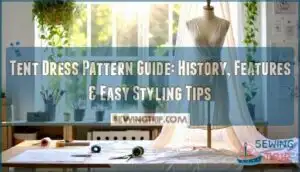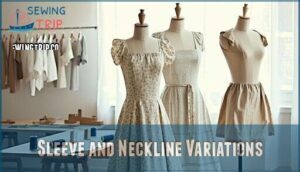This site is supported by our readers. We may earn a commission, at no cost to you, if you purchase through links.

You’ll love these beginner-friendly patterns because they require minimal fitting and use simple geometric shapes with straight seams.
Most tent dress patterns need just basic measurements and offer endless customization through length variations, sleeve options, and neckline choices.
The construction typically involves adding seam allowances—half an inch for most edges and two inches for hems.
These versatile patterns work beautifully in flowing fabrics like cotton, linen, or rayon, making them perfect for comfortable everyday wear or dressed-up occasions.
The magic happens in their effortless drape and forgiving fit that flatters various body types while keeping comfort front and center.
Table Of Contents
Key Takeaways
- You’ll find tent dress patterns perfect for beginners since they require minimal fitting skills and use simple geometric shapes with straight seams—just basic measurements and seam allowances.
- You can customize these versatile patterns endlessly through length variations, sleeve options, neckline choices, and fabric selections that work for both casual and dressy occasions.
- You’ll love how tent dresses flatter various body types with their forgiving A-line silhouette that provides comfort and movement while skimming over problem areas naturally.
- You’ll discover these patterns work beautifully in flowing fabrics like cotton, linen, or rayon, creating effortless drape that transforms simple construction into elegant, wearable garments.
The History of Tent Dress Patterns
You’ll discover that tent dresses trace their roots back to the liberating 1920s chemise dress, which broke away from restrictive corseted silhouettes of earlier eras.
This simple yet revolutionary design evolved through decades of fashion changes, gaining popularity in the swinging 1960s and experiencing modern revivals thanks to contemporary designers who recognized its timeless appeal.
Evolution of The Tent Dress Style
You’ll find tent dress patterns trace their silhouette origins back to the 1920s chemise dress, breaking free from restrictive corsetry.
This liberating design evolved through cultural impact across decades, with silhouette evolution reflecting changing fashion history.
The loose A-line shape gained designer influence during vintage fashion revivals, adapting fabric trends from structured materials to flowing textiles that defined modern adaptations of this timeless tent dress pattern.
Influential Designers and Trends
During the 1950s, Pierre Cardin revolutionized fashion with his 1957 trapeze design, laying groundwork for the tent dress pattern movement.
Yves Saint Laurent followed with bold interpretations that defined 1960s fashion icons’ wardrobes. These designer revivals sparked cultural shifts, transforming tent dresses from simple garments into artistic statements.
Modern adaptations by Cecilie Bahnsen and Tibi continue this legacy, while historical influences from 1920s chemise dresses shape contemporary vintage fashion trends and runway collections worldwide.
These dresses are available in a variety of styles, including long-sleeved and short-sleeved designs.
Popularity Throughout The Decades
You’ll discover tent dress patterns experienced major trend resurgences in the 1960s fashion scene and again in the 1990s.
The 1960s tent dress became synonymous with mod fashion and hippie fashion movements.
Modern revivals by designers like Victoria Beckham showcase how vintage sewing patterns adapt to cultural shifts, making vintage patterns increasingly popular today.
For those seeking inspiration, Pinterest hosts patterns for discovery, which can lead to a new understanding of vintage sewing patterns.
Features and Characteristics of Tent Dress Patterns
You’ll discover that tent dress patterns share key features that make them both comfortable and stylish to wear.
These patterns typically include a loose, flowy silhouette that starts from the bustline and creates an A-line shape, with various options for sleeves, necklines, hemlines, and fabric choices to suit your preferences, making them a comfortable option.
Loose and Flowy Silhouette
While tent dress patterns embrace a loose fitting dress silhouette, the magic lies in drape and movement.
Your tent dress pattern creates effortless fabric flow through strategic construction.
The comfort factor depends on fabric weight – lightweight materials enhance the aline dress pattern’s natural swing.
This comfortable dress pattern adapts seasonally, offering silhouette variations that flatter through graceful movement rather than restrictive tailoring, providing an overall comfort factor.
Sleeve and Neckline Variations
Your tent dress pattern becomes uniquely yours through thoughtful sleeve and neckline choices. These design elements transform a simple pattern into something special that reflects your personal style.
Transform any basic pattern into a personal style statement with the right sleeve and neckline combinations.
Consider these popular combinations for maximum impact:
- Sleeveless with boat neckline – creates clean, elegant lines perfect for summer occasions
- Cap sleeves paired with square necklines – adds vintage charm while maintaining the dress’s flowing silhouette
- Short sleeves with jewel necklines – offers classic versatility that works across seasons
Sleeve variations range from strapless designs to flutter sleeves, each changing how the tent dress pattern drapes on your body. Neckline options include sweetheart, V-neck, and scoop styles that complement different face shapes. When modifying your sewing pattern, remember that wider necklines balance the dress’s loose fit, while collar options can add structured contrast. These sleeve pattern and embellishment details let you customize your creation perfectly.
Hemline Options
Hemline measurement determines your tent dress pattern’s final look and versatility.
You’ll find asymmetrical hems create modern visual interest, while scalloped edges add feminine charm.
High-low hemlines offer dramatic movement and practical coverage. Tiered hems provide extra volume and texture.
Consider hem embellishments like lace trim or decorative stitching to personalize your dress length and make each creation uniquely yours.
For a professional finish, remember to explore baby hem techniques to achieve a professional finish.
Fabric Choices and Recommendations
Your fabric choice determines how beautifully your tent dress flows and drapes.
Cotton voile and rayon challis offer excellent drape and weight for comfortable wear.
Consider print scale when selecting patterns—smaller prints work well on flowing silhouettes.
Texture contrast adds visual interest through fabric types like smooth cotton against textured linen.
Choose seasonal fabrics: lightweight knit fabric for summer, heavier dress fabric options for cooler months.
Lining options help structured fabrics maintain proper fabric selection standards.
The fabric’s waterproof ratings will determine its suitability for different weather conditions.
Tips and Tricks for Sewing and Customizing Tent Dress Patterns
Creating a tent dress pattern gives you complete control over fit and style. You can easily adjust measurements, add personal touches, and make the dress uniquely yours with simple modifications.
Choosing The Right Size and Fit
Getting your tent dress pattern to fit right starts with accurate bust measurement since waist and hip measurements don’t matter much.
Focus on shoulder fit and ease allowance when selecting your size, as tent dresses need breathing room to achieve proper fabric drape. Understanding the importance of precise bust measurements can substantially improve garment fit.
Here’s your sizing roadmap:
- Measure your bust at the fullest point while wearing your intended undergarments for accuracy
- Compare finished garment measurements on the pattern envelope, not just the size chart numbers
- Choose based on bust measurement only – ignore waist and hip measurements for tent dress patterns
- Account for design ease – tent dress patterns include 4+ inches of intentional looseness in the bust
- Consider length adjustment needs by measuring from shoulder seam to desired hem before cutting
Modifying The Pattern for Individual Preferences
Your pattern’s foundation sets the stage for endless possibilities through strategic dress pattern modifications.
Start with sleeve alterations by extending short sleeves or adding bishop-style volume for dramatic flair. Experiment with neckline changes from round to V-neck or boat neck variations.
Adjust hemline variations by adding length segments evenly across the bottom edge. Consider adding pockets along side seams for functionality.
Your fabric choice affects how pattern adjustments drape and flow beautifully.
Adding Embellishments or Details
Transform your tent dress with creative embellishments that reflect your personal style.
You’ll discover countless ways to customize your pattern with dress modifications that make each piece uniquely yours.
- Sequins Application: Scatter sequins along the neckline or create geometric patterns for evening glamour
- Fabric Flowers: Hand-stitch delicate blooms across the bodice for romantic charm and texture
- Lace Panels: Insert contrasting lace strips down the sides or sleeves for elegant transparency
Consider Fringe Benefits along hemlines for movement, strategic Button Placement as decorative accents, or beading techniques for sparkle.
Many options exist for a sequin dress creation.
These pattern customization methods elevate basic dress design into personalized fashion statements through thoughtful dress pattern modifications.
Adjusting The Length and Proportions
You can easily modify your tent dress pattern to achieve the perfect fit by adjusting hemline variations and torso length.
Pattern modifications for dress length extension involve adding fabric width for volume adjustment. When making dress alterations, consider how fabric drape affects proportion balance.
For a professional finish, consider using bias binding techniques. Mark your desired hemline, then add seam allowances.
These dress modifications help create flattering proportions that complement your body shape perfectly, and are essential for a professional finish, which can be achieved by using the right techniques, such as bias binding, to ensure a polished look.
Styling and Wearing Tent Dresses
You’ve crafted your perfect tent dress, and now it’s time to bring it to life through thoughtful styling choices.
The right accessories and layering techniques can transform your simple tent dress from casual daywear to evening elegance, making it work for countless occasions and your unique body type, emphasizing the importance of elegance.
Accessorizing and Layering Options
Your tent dress pattern transforms into countless looks with smart accessorizing and layering.
Belts and scarves define your waistline while adding color pops. Jewelry choices like delicate chains or statement earrings complement the flowing silhouette without overwhelming it.
Shoe styles range from sneakers for casual days to heels for dressier occasions. Jacket pairings with denim or blazers create structured contrast.
Seasonal layers include cardigans for cool mornings or kimonos for beach vibes. These styling tricks maximize your tent dress’s versatility across different settings.
You can even upcycle old festival tents, as described in a tent dress pattern, to create a unique and sustainable fashion item with your own tent dress, using smart layering.
Suitable Occasions and Settings
You’ll discover that a tent dress pattern works beautifully for multiple occasions when styled correctly.
This versatile summer dress evolves from Casual Outings to unexpected settings with simple adjustments.
Perfect occasions include:
- Beach vacations and resort getaways for ultimate Vacation Wear
- Outdoor weddings and garden parties as elegant casual wear
- Music festivals and art fairs for comfortable all-day movement
- Weekend brunches and shopping trips for Everyday Comfort
- Evening dinners with strategic layering for Seasonal Adaptations
Your dress for all occasions shines brightest in relaxed environments where comfort meets style, making sewing for all occasions worthwhile.
Body Types and Suitability
Understanding how a tent dress pattern works with your body type can make the difference between feeling fabulous and feeling frumpy.
These flattering silhouettes aren’t one-size-fits-all solutions, but with smart fabric drape choices, they can boost confidence across different figures.
If you’re pear-shaped, tent dresses naturally balance your proportions by adding volume away from your hips.
Apple shapes benefit from the loose fit that skims over the midsection without clinging.
However, if you have an hourglass figure, the lack of waist definition might hide your curves—consider shape modification through belting or layering.
Plus size dress enthusiasts often find tent dress patterns forgiving and comfortable.
The key lies in choosing the right fabric weight and length proportions.
Body positivity means embracing styles that make you feel good, whether you’re sewing for all sizes or shopping ready-made options that celebrate dress for all body types.
Confidence and Personal Style Considerations
Your tent dress pattern should celebrate your unique shape, not hide it. Confidence comes from choosing designs that make you feel comfortable and authentic.
Whether you prefer a loose, flowing silhouette or add a belt for definition, trust your instincts.
Personal expression through sewing creates garments that truly reflect who you are. Body positivity means embracing style versatility – your tent dress can adapt to your mood and occasion.
Wardrobe integration happens naturally when you sew for all body types with intention and self-love.
Frequently Asked Questions (FAQs)
What are tent dress patterns?
Measure twice, cut once" applies perfectly here.
You’ll create tent dress patterns by drawing trapezoid shapes that flare from the bustline down.
These loose-fitting templates guide your fabric cutting for comfortable, flowing dresses without defined waistlines.
They help you make dresses with a flowing design, which is the main goal of this pattern-making process.
How do you make a tent dress?
Start by measuring your bust and desired dress length.
Cut fabric in a trapezoid shape – narrow at top, wide at bottom.
Sew shoulder seams first, then side seams.
Finish neckline with bias binding and hem edges.
What is a tent dress?
A tent dress is a loose-fitting, A-line garment that flares out from the bust without a defined waistline, resembling a tent’s shape.
You’ll love its breezy comfort and versatility for any occasion.
How do I choose a tent dress?
Choose lightweight fabrics like cotton or linen for comfort.
Consider your body shape – tent dresses flatter most figures.
Pick colors and patterns you’ll wear often.
Check measurements against sizing charts carefully.
Are tent dresses a good idea?
You’ll find tent dresses wonderfully liberating—they’re comfortable, flattering on most body types, and incredibly versatile for casual or dressy occasions.
What is the difference between a tent dress and a trapeze dress?
There’s no difference – tent dresses and trapeze dresses are the same garment with different names.
Both feature an A-line silhouette that flares from the bustline, creating that loose, flowing tent-like shape you’ll love.
When were tent dresses popular?
You’ll find tent dresses had their heyday in the 1920s, then made a comeback in the swinging 1960s and again in the 1990s, with modern designers reviving them today.
What is the simplest dress to make?
A tent dress stands as the simplest dress you’ll make.
It’s basically a rectangle with armholes—no zippers, darts, or fitted seams required.
You’ll cut, sew straight lines, and you’re done wearing comfort.
What seam allowances work best for tent dresses?
Don’t worry about precision being overkill—proper seam allowances prevent frustration later.
Use half-inch seam allowances for tent dresses.
They’re wide enough for secure construction yet manageable for curved seams and finishing techniques.
How do you calculate fabric requirements accurately?
Measure your bust, waist, and desired length. Add dress width (typically 45-60 inches) plus seam allowances. Multiply by pattern pieces needed. Always buy extra fabric for mistakes.
Conclusion
Mastering a tent dress pattern opens doors to endless creativity, comfort, and style possibilities.
You’ll discover that these versatile designs work for casual mornings, professional afternoons, and elegant evenings with simple accessory changes.
Whether you’re a beginner seeking your first sewing project or an experienced seamstress wanting effortless elegance, tent dress patterns deliver reliable results.
Your wardrobe will benefit from these forgiving fits that flatter various body types while providing the comfort you crave in today’s busy lifestyle.















